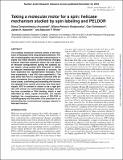Files in this item
Taking a molecular motor for a spin : helicase mechanism studied by spin labelling and PELDOR
Item metadata
| dc.contributor.author | Constantinescu Aruxandei, Diana | |
| dc.contributor.author | Petrovic-Stojanovska, Biljana | |
| dc.contributor.author | Schiemann, Olav | |
| dc.contributor.author | Naismith, Jim | |
| dc.contributor.author | White, Malcolm F | |
| dc.date.accessioned | 2015-12-22T20:40:04Z | |
| dc.date.available | 2015-12-22T20:40:04Z | |
| dc.date.issued | 2015-12-10 | |
| dc.identifier | 236138592 | |
| dc.identifier | 4938570e-a43a-4b48-9b61-251db030a21a | |
| dc.identifier | 84966263778 | |
| dc.identifier | 000371266000047 | |
| dc.identifier.citation | Constantinescu Aruxandei , D , Petrovic-Stojanovska , B , Schiemann , O , Naismith , J & White , M F 2015 , ' Taking a molecular motor for a spin : helicase mechanism studied by spin labelling and PELDOR ' , Nucleic Acids Research , vol. Advance Access . https://doi.org/10.1093/nar/gkv1373 | en |
| dc.identifier.issn | 0305-1048 | |
| dc.identifier.other | ORCID: /0000-0003-1543-9342/work/47136123 | |
| dc.identifier.uri | https://hdl.handle.net/10023/7926 | |
| dc.description | Welcome Trust programme grant [WT091825MA to M.F.W., J.H.N.]; Wellcome Trust multi-user equipment grant [099149/Z/12/Z]. Royal Society Wolfseon Merit Award (to M.F.W., J.H.N.). Funding for open access charge: Wellcome Trust [WT091825MA]. | en |
| dc.description.abstract | The complex molecular motions central to the functions of helicases have long attracted attention. Protein crystallography has provided transformative insights into these dynamic conformational changes, however important questions about the true nature of helicase configurations during the catalytic cycle remain. Using pulsed EPR (PELDOR or DEER) to measure interdomain distances in solution, we have examined two representative helicases: PcrA from superfamily 1 and XPD from superfamily 2. The data show that PcrA is a dynamic structure with domain movements that correlate with particular functional states, confirming and extending the information gleaned from crystal structures and other techniques. XPD in contrast is shown to be a rigid protein with almost no conformational changes resulting from nucleotide or DNA binding, which is well described by static crystal structures. Our results highlight the complimentary nature of PELDOR to crystallography and the power of its precision in understanding the conformational changes relevant to helicase function. | |
| dc.format.extent | 4823487 | |
| dc.language.iso | eng | |
| dc.relation.ispartof | Nucleic Acids Research | en |
| dc.rights | Copyright (c) The Author(s) 2015. Published by Oxford University Press on behalf of Nucleic Acids Research. This is an Open Access article distributed under the terms of the Creative Commons Attribution License (http://creativecommons.org/licenses/by/4.0/), which permits unrestricted reuse, distribution, and reproduction in any medium, provided the original work is properly cited. | en |
| dc.subject | QH301 Biology | en |
| dc.subject | NDAS | en |
| dc.subject.lcc | QH301 | en |
| dc.title | Taking a molecular motor for a spin : helicase mechanism studied by spin labelling and PELDOR | en |
| dc.type | Journal article | en |
| dc.contributor.sponsor | The Wellcome Trust | en |
| dc.contributor.sponsor | BBSRC | en |
| dc.contributor.institution | University of St Andrews.School of Chemistry | en |
| dc.contributor.institution | University of St Andrews.EaSTCHEM | en |
| dc.contributor.institution | University of St Andrews.Biomedical Sciences Research Complex | en |
| dc.contributor.institution | University of St Andrews.School of Biology | en |
| dc.identifier.doi | 10.1093/nar/gkv1373 | |
| dc.description.status | Peer reviewed | en |
| dc.identifier.grantnumber | 091825/Z/10/Z | en |
| dc.identifier.grantnumber | BB/H017917/1 | en |
This item appears in the following Collection(s)
Items in the St Andrews Research Repository are protected by copyright, with all rights reserved, unless otherwise indicated.

